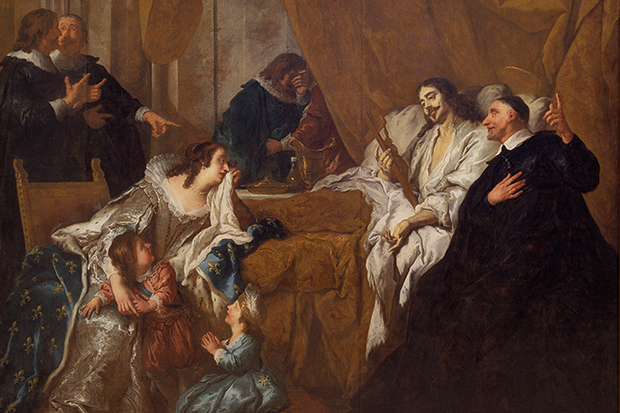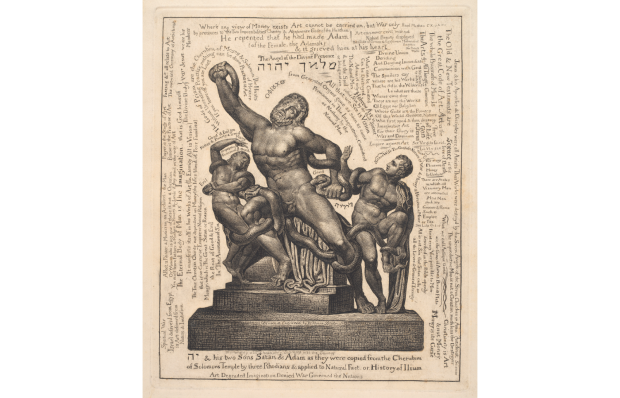At the beginning of the summer of 1715 Louis XIV complained of a pain in the leg. In mid-August gangrene set in and by 1 September he was dead. He’d been on the throne for 72 of his 77 years. A new exhibition at Versailles looks at the elaborate rituals that followed.
The Sun King died as he had lived — in public. Despite his illness, he carried on his daily routine until two days before his death, a decision made easier perhaps by the fact that he’d always conducted a good part of the affairs of France from his bedroom. It was no ordinary bedroom, and what went on there wasn’t ordinary either. It is in the exact centre of the palace façade, so the view from his bed would have cut straight down the middle of the magnificent gilted approach to the palace he built, a line which is, not at all coincidentally bien sur, the East–West axis of the sun.
Here, each day began with the ‘lever du Roi’. Over a period of an hour and a half, the king was dressed and received visitors beginning with the most intimate — his brother, his son — and ending with more distant courtiers and lords. By the time he had his wig on his head and his sword fixed to his belt, and was pulling on his gloves, his bedroom would be full of people. Each day ended with the ‘coucher du Roi’, which was the same thing in reverse.
The day after the king’s death, his body was cut open, divided into three parts (body, heart and entrails) and embalmed by doctors and surgeons in front of the principal officers of the court, before being placed in a coffin made of lead, which was placed in a coffin made of oak.
The practice of dividing dead French kings into three began with Philippe le Bel in 1314. The idea was that instead of one you could have three final resting places where people could come and pay homage (or, in more troubled times, desecrate the remains and pillage the metals). Louis’s double coffin stood in Versailles for eight days.
In a departure from tradition, no funeral effigy was made. Previously, following a Roman practice revived by the English, a wicker effigy of the dead king had been made (in England it was made of wood) and to this were fixed a wax mask and wax hands moulded from the dead king’s body.
The effigy was then dressed and sat up in bed where it received visits from mourners in place of the real body which, having started to reek, was enclosed in a coffin. A meal would be eaten in the company of the effigy during which it was served each course as if it were the living king. These effigies also played a big role in the funeral processions as they would be positioned on top of the dead kings’ funeral carriages and paraded through the streets of Paris where the people would flock to see them. Louis XIV’s father Louis XIII put an end to this practice, which he considered unacceptably pagan.
In the 16th and 17th centuries, women wore mourning white, but by the 18th century black was firmly established as the colour of mourning. With one exception — the king’s heir. Louis XIV had spent much of his life feeling rather good about himself in respect to his succession. Unlike those poor Spanish Bourbons who had all sorts of problems making heirs, he had had six children with his wife Marie-Thérèse, two of whom were boys. But just before he died, things started to go wrong. His eldest son Louis, known as the Grand Dauphin, died in 1711, and the following year his eldest son, also called Louis, died too. But this was not before bringing into the world a son called Louis who died, a second son called Louis who died and a third son called Louis, who not only survived but also went on to give his name to a type of chair.
Back in 1715, though, on his great-grandfather’s death, the future Louis XV, aged five, was not allowed to visit his dead relative, take part in his funeral procession or go to the funeral. And he didn’t wear black; he wore purple. This was to signify that, although kings die, the king, if you get my meaning, does not.
The other mourners, who came to sprinkle holy water on dead Louis’s coffin, wore black. Who wore what mourning attire was strictly regimented. The higher the rank of the mourner, the longer the train he was allowed to wear. The most important wore black trains five metres long.
Certain rooms in the Palace of Versailles were draped in black as were carriages. Servants wore black and so did the horses. As night set in on 8 September, Louis XIV’s funeral procession left Versailles for the basilica at Saint Denis, the ancient burial place of French kings. The basilica — which today is in the middle of a neighbourhood where the population is almost entirely of African origin — contains the remains of all but three of the 70-odd kings that ruled France starting with Clovis in the 5th century.
We don’t know why they chose to slow march those 12 hours of road at night. Perhaps it was the influence of Spain, where they’d developed a taste for night-time religious ritual. The effect, in any case, would have been dramatic. The procession was 2,500 people strong — many of them the king’s guards, mounted and on foot, around the king’s three metre-high funeral carriage surmounted with a large silver cross. At the front were 400 poor people, who were paid and dressed for the occasion in black cloaks with black hoods. All carried candles.
As they walked through the streets, with drummers keeping the slow, funereal beat, some in the crowds shouted insults as Louis’s funeral coach rolled by. Many people in France were glad to see the back of France’s longest-serving monarch.
The procession arrived at dawn at St Denis for the funeral where musicians played Philidor’s Funeral March. The five metre-long ermine-lined cloak of blue velvet and gold fleurs-de-lys, his crown and the sword that had belonged to Charlemagne were placed upon the coffin. Inside were placed models of his shield, his spurs, his sceptre, which symbolised authority, and his ‘hand of justice’, which symbolised the overseeing of order.
The body was buried at St Denis where it was dug up at the beginning of the Terror in 1793 and scattered along with the remains of other kings. The copper plaque identifying the coffin was pillaged and turned into a saucepan. Straightened out again, it is on display in the exhibition.
Louis’s heart was put in the Jesuits’ church in the rue St Antoine, where looters also came during the Revolution and took the gold that encased it. Though this heart was destroyed, the exhibition contains three other royal hearts set in gold in the same way. Only the Sun King’s embalmed innards remained undesecrated by the Jacobins. A recent discovery allowed the identification of the exact location of the barrels containing the entrails of Louis XIV and his father at the foot of the steps to the sanctuary of Notre Dame Cathedral.
Got something to add? Join the discussion and comment below.
Get 10 issues for just $10
Subscribe to The Spectator Australia today for the next 10 magazine issues, plus full online access, for just $10.
You might disagree with half of it, but you’ll enjoy reading all of it. Try your first month for free, then just $2 a week for the remainder of your first year.














Comments
Don't miss out
Join the conversation with other Spectator Australia readers. Subscribe to leave a comment.
SUBSCRIBEAlready a subscriber? Log in